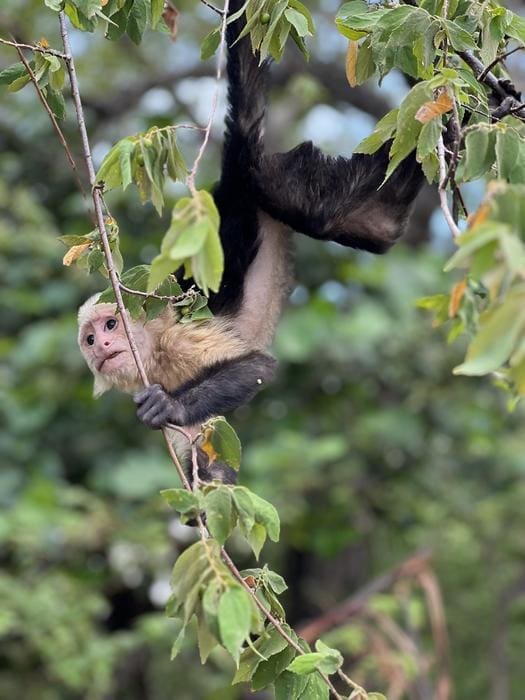Heat sensitivity weakens immune performance in wild monkeys
A study from the University of Michigan reveals that wild capuchin monkeys experience a decline in immune system performance when subjected to warmer temperatures.
Led by U-M doctoral student Jordan Lucore, the research focused on a population of white-faced capuchins in the Taboga forest reserve of Costa Rica, observing their response to two-week periods of temperatures around 86°F (30°C). Results indicate that the monkeys’ generalized immune systems – activated immediately when the body detects a threat – function less effectively under these conditions.

The findings, published in Science Advances, challenge expectations about temperature resilience in mammals.
Lucore emphasized the implications for understanding climate change effects, stating: “Eighty-six degrees Fahrenheit is not that hot,” underscoring the surprising vulnerability of capuchins, often regarded as resilient generalist species. Notably, younger monkeys exhibited the most significant immune declines, which could have critical consequences for their health and survival, as their adaptive immune systems remain underdeveloped.
Urine samples collected via non-invasive methods allowed researchers to measure neopterin levels, a biomarker linked to immune activity.
These measurements, combined with temperature data, revealed the connection between immune performance and prolonged heat exposure. Longer-term studies are needed to determine whether these effects have lasting health or reproductive impacts on wild populations.
Lucore concluded: “Climate change is happening. It’s going to have effects on anyone living on Earth in ways that you may not expect, and especially on these fundamental systems that we need to survive. The fact that a graduate student like me can go out there and collect rather short-term data and find strong evidence that temperatures are affecting the physiology of wild animals – I think that’s a pretty important thing to keep in mind.”
The Capuchinos de Taboga field team, specifically co-authors Amy White, Lorena Sinclair, Vasco Alexandre Martins, Sarah Kovalaskas and Juan Carlos Ordoñez, were instrumental in the study. Co-author Andrew Marshall, U-M professor of anthropology and of ecology and evolutionary biology, provided critical analysis and interpretation of the study.
Journal Reference:
Jordan M. Lucore et al. ‘High temperatures are associated with decreased immune system performance in a wild primate’, Science Advances 10, eadq6629 (2024). DOI: 10.1126/sciadv.adq6629
Article Source: University of Michigan
Mechanisms behind plants’ stomatal responses to heat and drought unraveled
A study led by researchers at VIB-UGent has identified a signaling axis that regulates the opening and closing of stomata – tiny pores on plant leaves – during high temperatures and drought.
Published in Nature Plants, the findings offer insights into how plants balance conflicting responses to environmental stresses, paving the way for breeding more climate-resilient crops.
Stomata, often likened to the sweat glands of plants, play a vital role in regulating gas and water exchange. When exposed to high temperatures, stomata open to release heat, but they close during drought to prevent water loss. This dual challenge is compounded during simultaneous heat and drought conditions. The research team identified a phosphorylation-mediated signaling mechanism controlling these stomatal responses.

Dr. Xiangyu Xu, the study’s first author, explained how specific protein kinases act as switches for stomatal aperture. TOT3, a kinase associated with high temperatures, promotes stomatal opening, while OST1, active during drought, inhibits TOT3 through phosphorylation, enabling stomatal closure. This dynamic regulatory process enhances plants’ ability to respond to combined stresses efficiently.
“Opening and closing of stomata are rapid responses that require switch-like signaling mechanisms,” Xu said. “We know that phosphorylation-encoded switches within protein networks are reversible and tend to be faster than genetic switches. That’s why we studied the role of kinase-mediated phosphorylation relays in stomata opening and closing.”
Prof. Ive De Smet highlighted the broader implications: “For years our research has focused on the impact of extreme weather conditions on plants. The molecular insights we gain can lead to solutions to enhance plant resilience. In essence, we learn from the natural mechanisms that plants themselves deploy. For instance, how stomata on leaves play a crucial role in the plant’s interaction with the environment. This makes insights into their activation mechanisms highly valuable.”
Journal Reference:
Xu, X., Liu, H., Praat, M. et al. ‘Stomatal opening under high temperatures is controlled by the OST1-regulated TOT3–AHA1 module’, Nature Plants (2024). DOI: 10.1038/s41477-024-01859-w
Article Source: VIB Press | Vlaams Instituut voor Biotechnologie (VIB)
Blueprint for equitable water access fosters peace and sustainability
A study published in Nature Water outlines a seven-point strategy for managing global water resources sustainably and equitably.
Led by the University of Birmingham, the research highlights water’s potential to foster peace and security by reducing competition and mitigating conflicts over this critical resource.
The strategies emphasize collaboration at local levels, integration of indigenous knowledge, gender equity, and improved predictive tools for water-related challenges. Examples like the Middle East’s EcoPeace project and the Indus Waters Treaty between India and Pakistan illustrate how international cooperation can address water disputes effectively.
Professor Stefan Krause, the study’s lead author, noted, “Water can be a powerful tool for peace when managed sustainably and equitably.” The researchers stress the importance of interdisciplinary collaboration and participatory approaches, leveraging open science and nature-based solutions to achieve UN Sustainable Development Goals.
Journal Reference:
Krause, S., Lynch, I., Agarwal, A. et al. ‘Seven strategies to leverage water for peace and foster sustainable and just water management for all’, Nature Water (2024). DOI: 10.1038/s44221-024-00353-z
Article Source: U-B Press | University of Birmingham
Featured image credit: Gerd Altmann | Pixabay




